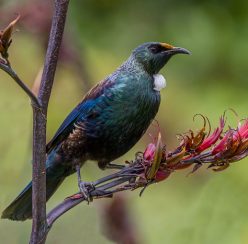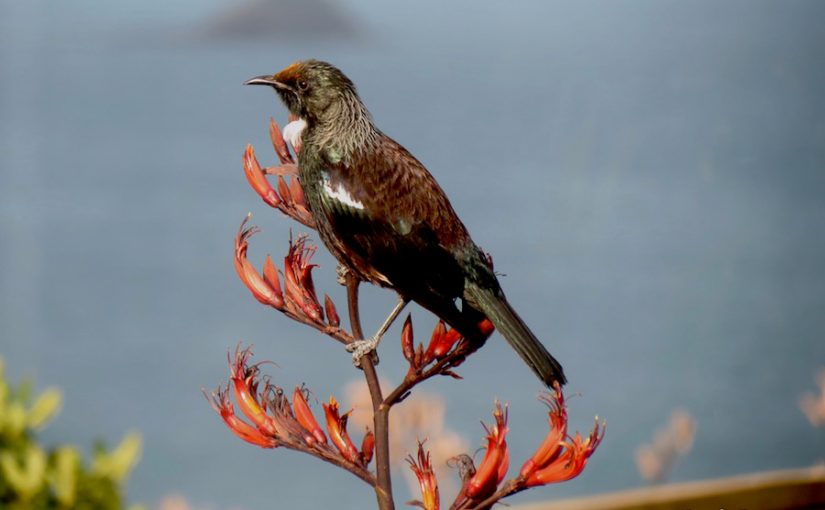On my most recent island visit I got some feedback that people were looking to do some winter planting on their patches of land to attract our local bird-life, and were looking for advice on how best to achieve that. I’m no expert, and would always advise chatting to Rakino Nursery manager John MacKenzie before embarking on an ambitious planting plan, but here is a bit of basic information to get started with.
Below is a chart of native birds we see on Rakino, and their favoured foods. The nectar feeders prefer insects at nesting time, as they feed their young insectivorous protein. Planting insect attracting shrubs and trees like manuka and kanuka will ensure you always have insect-gobbling fantails and grey warblers flitting through your garden, and will also provide nourishment for the young’uns of nectar feeders. We watched a tui bashing a large stick insect senseless against a tree down at Sandy Bay in preparation for a tui family feast..
Another very good reason to plant manuka/kanuka is that it’s a great habitat for geckoes and skinks. The jury is out on whether we have geckoes on Rakino or not, but we definitely have a number of native skinks. Muhlenbeckia is also a very good habitat for lizards, and John is currently germinating muhlenbeckia seeds due to popular demand.
I have noticed that kakariki love flax seeds, so I would definitely advise the planting of harakeke if you love tui, bellbirds, and are hoping for kakariki to visit, as I am. Aside from this, it’s a great firebreak, and will self germinate readily.
| species | nectar | fruit & seeds | foliage | insects |
| tui | * | * | * | |
| waxeye | * | * | * | |
| grey warbler | * | |||
| fantail | * | |||
| king-fisher | * | |||
| bellbird | * | * | * | |
| kaka | * | * | * | |
| kakariki | * | * | ||
| wood pigeon kereru | * | * |
Below is a list of some of the trees that are generally available to purchase at the plant nursery. Many are currently sold out but I’ll share the link so you can see for yourselves what’s available. The list below isn’t comprehensive, just an indication.
| species | fruit & seed | nectar | insects |
| nikau | * | ||
| taraire | * | ||
| karamu c. robusta | * | ||
| taupata c. repens | * | ||
| cabbage tree | * | * | |
| pigeon-wood | * | ||
| tawapou | * | ||
| kawakawa | * | ||
| mahoe | * | ||
| harakeke flax | * | * | |
| five-finger | * | ||
| kowhai | * | ||
| puriri | * | * | |
| karo | * | * | |
| kanuka | * | ||
| manuka | * |
Most of the above trees are also attractive to insects, but manuka and kanuka are specifically attractive, and flower frequently.
I’d also like to give a plug to the humble bottlebrush, or callistemon. It’s an Australian native, and not available at the nursery, but it’s irresistible to bellbirds, and bees, and flowers readily. If you are bringing bottlebrush over from the mainland, please ensure you place it in a bucket of water and soak it thoroughly in order to avoid any nasties like plague skink eggs being inadvertantly transported also. I soak any plants I’m transporting overnight, such is my level of paranoia about pests.
I’ll defer to John MacKenzie with regard to what to plant and where; some trees don’t like wet feet, some dislike the dry, others are comfortable almost anywhere. Manuka, harakeke, karamu, taupata, karo, and five-finger make great regenerative ‘nursery’ plants and are very forgiving. A hard to kill plant is a good plant. They’ll provide shelter and shade for more temperamental trees.
The other thing to keep in mind is that once you have a few trees in the ground and the birds are visiting, they will spread the seeds they are eating through the digestion process, and many will germinate successfully.
Happy planting!
https://www.rakinoisland.org/nursery
Photo credit- Jennie Cruse

